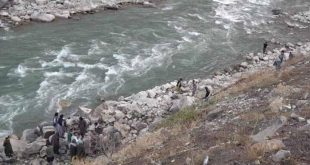By Alias Wardak
Afghanistan is suffering for more than four decades from a devastating war that cannot be limited to the country’s boundaries, but that has regional and even international dimensions. Starting with the Coup d’état by the Communist Party in 1978 and the Soviet Union’s subsequent invasion, millions of Afghans were forced to live their country and migrate. The major part migrated to Pakistan and Iran, and only a minor portion could find refuge in Europe and the United States. This process continued to be the case due to the civil war and during the Taliban rule in Afghanistan until the late 1990s. Conflict-induced migration will continue to be the leading cause in Afghanistan’s case, as proven by the recent flow of migrants into Europe in years between 2015 to 2017. Still, thousands of Afghans are waiting in refugee camps in Greece and Turkey to reach their final destination-mainly Central Europe.
Besides the aforementioned conflict-induced migration, migration caused by climate change in Afghanistan might increase the number of internally displaced people and the flow of migration in the next years and decades, if not effective measures are considered by the Afghan government and the international partners.
Afghanistan is assessed as one of the most vulnerable countries affected by the adverse impact of climate change, in particular in relation to droughts and floods. Droughts and floods are indicated as primary drivers for climate change-induced migration in the country. According to recent research by scientists from the University of Bratislava, in 2018 approx. 550,000 Afghans were forced to leave their “dwellings due to loss of livelihood” because of conflict or drought. Temperature is estimated to increase more than the global average, with warming expected to reach 1-7-2.3 Celsius by 2050. Moreover, changes in timing and volume of precipitation are likely, and spring rainfall is likely to decline in most parts of the country. The research further outlines that by 2030 droughts will become a norm, and flood events will undoubtedly intensify.
Another study conducted by the National Environmental Protection Agency (NEPA) in cooperation with UNEP and WFP, which focuses on the impact of climate change on livelihood and food security, shows that (a) droughts due to reduced spring rainfall, (b) drought caused by declining river flows as a consequence of a reduction in spring-time snowmelt in highlands, (c) floods due to an increased heavy spring rainfall and finally (d) riverine floods due to heavier and faster snowmelt in the highlands are the most considerable risks to livelihood in Afghanistan. Another research conducted in 2016 by Lukas and Ruettiger on the links between climate change and non-state armed groups points out the intertwines between natural resources and their role in conflicts in Afghanistan’s case. The research reveals that “water per capita availability will decline by 50 percent in 2040, as a result of rising temperatures, increased evapotranspiration and lower levels of rainfalls, and weak infrastructure and water management systems ……”. Moreover, as an upstream riparian country, Afghanistan faces challenges not only on a national level but the conflict potential over transboundary waters with its two neighbors- Iran and Pakistan- will rise as a consequence of water scarcity due to climate change in the region.
Looking at the national and regional dimensions of climate change challenges in Afghanistan, it is very likely that Afghanistan will be the primary victim of climate change. These challenges will heavily impact the livelihood of its people (agriculture employs 60 percent of the population) and foster armed conflicts induced by its neighbors that will, in particular, affected by the decrease of water availability in upstream Afghanistan.
Consequently, the likelihood of an increase in migration due to conflict with climate change as the root cause is high and must be considered a main factor for future migrants flow into other regions of the world, mainly Europe. In the case of Afghanistan, the interlinks between climate change and possible conflicts on a national and regional level due to droughts and water scarcity are evident. They could lead to further destabilization of the broader region between Central and South Asia.
Therefore, joint efforts by the government, regional countries, UN, and leading countries from Europe to reduce the impact of climate change in Afghanistan are critical and have to be undertaken through sustainable approaches contemplating national and regional climate change dimensions in Afghanistan. Otherwise, the massive flow of migrants will be a substantial economic burden, in particular, for the European countries as the main destination of refugees and will further deepen the crisis in Afghanistan and the region between Central and South Asia.
Alias Wardak is an expert on energy, water, and regional cooperation and a former policy advisor to Afghanistan’s Ministry Finance. He is a lecturer on infrastructure development in developing countries at the University of Siegen, Germany. He can be followed on Twitter: @AliasWardak.
 Afghanistan Times
Afghanistan Times




